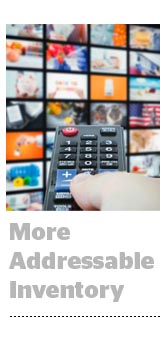
Despite the massive steps the ad industry has made in figuring out addressable TV just this year, advancement comes not from stunning breakthroughs, but simply from attaching a few additional pipes and freeing a new trickle of inventory or data.
On Thursday, Adobe Advertising Cloud TV soldered together a few more of those connections by hooking into Experian’s ConsumerView database and Mosaic USA household segmentation system, which will improve Ad Cloud TV’s addressable TV targeting.
Ad Cloud TV also connects to Clypd, so it can automate audience targeting, buying and measurement across Clypd’s network of broadcast partners. And it has a connection with Cadent, so advertisers can buy inventory across Cadent’s national network.
These relationships add to Ad Cloud TV’s existing inventory partners, which include NBCUniversal.
“We’re building a bridge from one side, and people like Clypd are building the bridge from the other side,” said Todd Gordon, director of programmatic TV at Adobe. “In some cases, we can drive across. In other cases, it’s a work in progress, but I would expect a significant amount of TV inventory will be able to be transacted in that dynamic way over the next year.”
So what sort of inventory is available for programmatic transactions, especially from a major source like NBCU?
Very occasionally, there’s broadcast prime-time inventory, but in general, Gordon said, it skews toward the cable portfolio, which includes Primetime USA and Bravo.
“You can buy premium programs and premium dayparts, and you can buy longer-tail networks,” Gordon said.
Adobe Ad Cloud TV is largely architected from TubeMogul, the video DSP it bought in 2016 for $540 million. At the time, TubeMogul focused on desktop pre-roll and was shifting into mobile formats. But with TV and digital buying converging, TubeMogul and other DSPs that once focused on online ads – including MediaMath and The Trade Desk – have slowly built out their TV buying businesses.
And that’s kept their relationships strong with big agency buyers. Dentsu Aegis Network, for instance, had a relationship with TubeMogul four and a half years ago, said Michael Law, the EVP managing its video investments.
That relationship persists with Ad Cloud TV: “Right now,” Law said, “almost all of our ad dollars go through Adobe.”
Dentsu is both an ad buyer and an inventory source. Law said the holding company has video inventory it owns, which it mixes with open-market inventory, all of which can be purchased through the Adobe platform. For Law, the secret sauce is the ability to optimize ad buying by understanding both the defined user who’s being targeted and the factors that determine inventory pricing.
Part of Ad Cloud TV’s ability to power this optimization comes from the fact that it’s a connected system: It does planning, buying and measurement. That combination can be controversial, leading to accusations of grading its own homework. Platforms like VideoAmp, for instance, pointedly extracted its buying capability.
But Adobe’s Gordon says a unified system is necessary. It’s not advantageous to have, for instance, a ranking of inventory sources that exists in a vacuum without information about what the advertiser already bought.
“It doesn’t take into account that once you buy what’s No. 1 in the ranker, it might need to be reset because you’ve already reached your audience,” Gordon said. “If ESPN is No. 1, and ESPN2 is No. 2, then after you buy ESPN, maybe ESPN2 isn’t as important.”
This post was syndicated from Ad Exchanger.


More Stories
Marketing Morsels: Hidden Valley Ranch, La-Z-Boy, Topps & More
Flashback: Jane Pauley and Deborah Norville Revisit Today’s 1989 Succession Drama
Ally Financial Revives ‘Banksgiving’ With A TikTok Twist